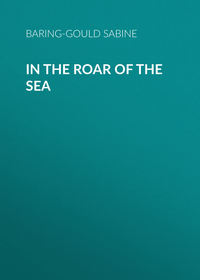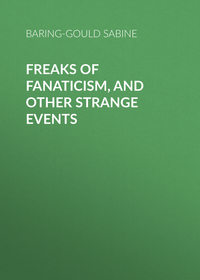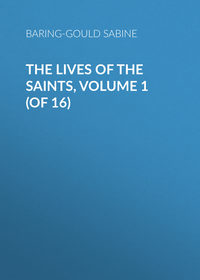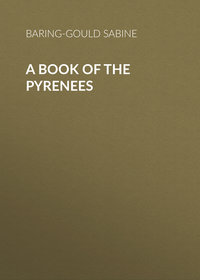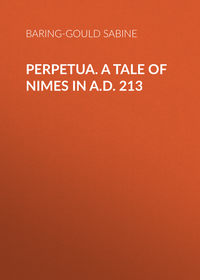 полная версия
полная версияA Book of North Wales
Shortly after this “Magna et verbosa epistola venit e Capreis,” the violent tirade of Gildas was launched at the heads of the British princes. Now one of the companions of Cybi was Caffo, a brother of Gildas. Maelgwn insisted on his dismissal, and Cybi reluctantly obeyed. Caffo left and got as far as Rhosyr, now Newborough, in Anglesey, when some shepherds of Maelgwn’s queen, incensed at the indignity put on their master, fell on him and killed him. The church of Llangaffo marks the site of the murder. This took place about 545, and Maelgwn died of the yellow plague in 547. Cybi survived him to about 554.
There is a menhir at Clorach, near Llanerchymedd, with a curious hunch on it, popularly called “Tyfrydog’s Thief.” The story goes that a thief got into the church of Llandyfrydog and stole the Bible, put his spoil on his back, and ran away, but was turned to stone with the Bible he had carried off.
Not far from this prehistoric monument were two wells called after S. Cybi and S. Seiriol. Here they were wont to meet at midday, Cybi walking from the west and Seiriol from the east.
Cybi would start in early morning along the old Roman road, and he had the sun in his face all the way, and in like manner Seiriol had it behind him. They met at noon, and lunched together and drank from their respective wells. Then Cybi turned west to retrace his steps, so also did Seiriol; and consequently Cybi had the evening sun blazing on his face for his homeward walk, and Seiriol was still in dusk, with his shadow running before him. The result was that Cybi was tanned, whereas Seiriol remained fair, and the former on this account obtained the name of Cybi the Tawny and his comrade from Penmon that of Seiriol the Fair.
Matthew Arnold wrote a poem on the meeting at Clorach, but not knowing the place, and not knowing the directions taken, missed the point of the story.
The church of Caergybi is fine. The chancel is Early English, with a Decorated east window. There was intended to have been a central tower, and the church was a cross church originally. The tower was never completed. The porch and side aisle are rich Perpendicular, and there is some quaint carving outside the south transept; and the south doorway within the porch is peculiarly rich, though the figure sculpture is poor. Over the door in a niche is the Trinity, popularly mistaken for a representation of Maelgwn Gwynedd. A south chapel, in excellent taste, from the designs of Mr. Harold Hughes, has been erected, with niches containing statuettes of Cybi and Seiriol. It contains a recumbent figure of the Hon. William Owen Stanley, good, but wrongly placed.
The nave has internally on each side an arcade of three Tudor arches. On the north, the piers are octagonal; on the south, clustered of four shafts, with general capitals. The arrangement of the transepts is clumsy, like other Welsh examples, running from north to south, uninterrupted by arches, and giving the effect of one church set at right angles to another.
Capel y Llochwyd is on the mountain. Bishop Stanley, in 1830, thus describes it: —
“A singular fissure, cleaved in a direct line from the summit to the base, forms, or rather did form, a passage of communication of no small celebrity in ancient days, and retaining its odour of sanctity till very recent date. It is known by the name of Ogof Lochwyd, ogof signifying a cave. A spring of crystal water filtering through the deep strata formed a deep well at the bottom of this chasm. Situated just at the higher opening of the gorge was a chapel for the accommodation of pilgrims called Capel y Llochwyd, of which a considerable remnant in ruins at the head of this gorge still remains. Till within sixty years the lonely chapel with its well were from time unknown the resort of lads and lassies of the island, who, at a certain annual festival called Suliau y Creiriau, the Sundays of the Relics, and held during three successive Sundays in July, assembled in troops to ascertain the contingencies awaiting them. Each diviner into futurity descended the chasm to the well, and there, if after having taken a mouthful of holy water and grasped two handfuls of sand from the charmed font, he or she could accomplish the re-ascent with them safely, each would obtain the wish of their heart before the close of the year. About sixty years ago (1770) the chapel was reduced to ruins, and the well was concealed by filling it with rubbish; but till twenty years ago the walls, to the height of seven or eight feet, remained sufficiently entire to convey a tolerable idea of the perfect building, which is represented to have been a substantial though rude and primitive edifice, composed of unhewn stones cemented with mortar, the windows and doorways excepted, which were well wrought by the chisel with considerable labour from some obdurated material, the whole apparently consisting of one oblong chamber not exceeding a few yards in length.
“Of the well, however, not a trace was left, though its existence was proved beyond a shadow of doubt a few years ago by a party who landed and at length succeeded in detecting the spot, from whence, after removing a quantity of sand and loose stone, again gushed the fountain of water in its pristine vigour and doubtless inherent virtues.”
There was at one time a chapel of S. Ffraid or Brigid on an islet where according to legend she disembarked from Ireland. This was not the Brigid of Kildare, but a namesake. The story goes that being unable to find a boat to serve her purpose, she cut a sod of turf, threw it into the sea, stepped on it, and was carried across. The turf lodged on this hump of rock, and became fast there. But the wintry waves have eaten away the isle, chewed up the turf, and torn down the chapel walls.
The breakwater of Holyhead is a stupendous achievement. It is about a mile and a half long, and has a lighthouse at the extremity. On the Skerries also, some seven miles north, is another lighthouse, and the Government had to buy it from the owner, a Mr. Jones, for the sum of £444,984.
The old Government pier had already cost a million and a half of money, but it was abandoned when the London and North Western Railway Company undertook the construction of the new pier. The new harbour has a water area of twenty-four acres.
Every visitor to Holyhead makes a point of going to the South Stack, just under four miles from the town. Cliffe thus describes it: —
“At first you feel disappointed, and it is not until you descend that you become impressed with the grandeur of the scenery. At the foot of the formidable stairs, 380 in number, you arrive at the entrance of a light suspension bridge. For some years after the lighthouse was erected (1809) the only means of access across the chasm was by a rope and basket; then a bridge of ropes was made, but the risk was so great that a chain bridge became necessary. After crossing the bridge you can descend to look at a vast fissure in the islet, and wonder, if the day be stormy, how the boats fared that conveyed the materials for the lighthouse to that rugged and perilous spot, where the surge of the sea is awe-inspiring. The sea in south-westerly gales often dashes over the dwellings of the lightkeepers, when the scene is truly sublime.”
The coast is alive with sea-birds, kittiwakes, razorbills, guillemots, solan geese, puffin, shag, cormorant, and tern; and collections of these birds’ eggs can be obtained at a very small cost in the town. An ingenious provision of Nature saves the eggs from being carried by the raging winds from the ledges of rock on which they are laid, when the mother-bird is not sitting. If, for instance, a guillemot’s egg be looked at, it will be seen that it is so balanced that the wind, catching it, spins it round on its centre of gravity, and does not obtain sufficient resistance to carry it away bodily, and precipitate it into the sea.
There are objects of considerable archæological interest in Holy Island, and these are the Cytiau’r Gwyddelod, or habitations of the Irish. There are several collections, and some were explored by the Hon. W. O. Stanley in 1871.
They are strewn over the side of Holyhead mountain, but there are others by Porth Dafarch and Mynydd Celyn.
The sites of ancient habitations have been selected for shelter from the prevailing winds, and the huts are usually grouped together forming villages of from twelve to fifty huts. They are always protected from hostile attack by rude walls of dry masonry or by precipitous rocks. They are circular, and have slabs of granite set on end to face them within and without. The entrances are to the south. The roofs were constructed of poles resting on the low walls, brought together in the middle, and thatched or covered with turf. The walls of the huts enclose a space of from fifteen to twenty feet in diameter, and the doorway is formed of two upright stones of about four feet high, upon which formerly rested a stone lintel.
Some of these huts were dwelling-houses, others served merely as kitchens, and some were sweating or bathing chambers, by the production of steam by throwing water over heated stones.
Mr. Stanley found bronze weapons, jet necklaces, ornamented spindle-whorls, stone lamps, and moulds for bronze buttons. The abundance of articles discovered in these dwellings is very unusual and seems to point to their having been left in a hurry.
There is a strong camp, Caer-y-Twr, on Holyhead mountain, facing east, and about two-thirds of the way up to the summit from the town. It is surrounded by a rude wall of dry masonry, following the ridge of the rock, which in places is almost perpendicular. The entrance is steep and seems to have been defended by hornwork.
There is a narrow cleft in the face of the mountain to the west, above débris of rock that has fallen in some convulsion of nature, leaving a perpendicular face of rock two hundred feet in height. This gap forms a passage through which only one person could pass at a time, and a steep path winds to it between rock faces. It may have served as a postern to the camp.
The construction of huts in the fashion described was derived by the Irish from the original population of the isle, the people who erected the rude stone monuments.
A traveller in Gilead and Moab will find precisely similar collections of hovels, similarly surrounded with walls of unhewn blocks, and associated, as in Ireland, with cromlechs and cairns and menhirs, the relics of the same prehistoric race which through long centuries, and after long journeys to new lands, continued to build houses, erect camps, and set up monuments to their dead in Ireland, Wales, Scotland, Cornwall, and Northern Africa precisely as they did in Central Asia and in Palestine. A mysterious people that never advanced in the art of building, but clung tenaciously, as the bee, the bird, the spider, and the ant, to traditional usage in the structure of their dwellings, and which clung with like tenacity to the cult of ancestors. It came out of Asia with polished stone weapons, and only slowly accepted, as foreign importations, axes and swords and personal ornaments, made of bronze.
Certainly these were the most conservative people that ever overran Europe; and possibly that clinging to old institutions, that aversion to change, which brought ruin on the Welsh cause, may have been due to the large admixture of Iberian blood in the Cymric veins.
Take the Welshman of the present day. In his politics he is a Liberal, but in his bent of mind, in his mode of life, in his social relations, he is the most conservative of men.
This tenacity to what is old and customary is a valuable asset; it counterbalances the volatile and experimental tendency to adopt every novelty, and wreck every institution to supplant it with what is new and untried, but which is loud in promise.
It may be, it probably is the case, that there is much of this immobility in the English race. It is because of this that the American and German are beating us in manufacture and commerce, and if we are ever routed in the field, it will be due to the clot of it that has settled in our War Office not having been expelled.
CHAPTER V
BANGOR AND CARNARVON
Foundation of Bangor – Madog the Fox – The cathedral – Owen Gwynedd – Visit of Archbishop Baldwin – “Lazy-tongs” – Llanidan – Shrine of S. Nidan – Curious phenomenon of the filling stoup – Bust of Edwen – Llanfair – Owen Tudor – The fable of the Welsh pot-girl – Carnarvon – Elen the Road-maker – Maximus – Edward of Carnarvon – Hugh the Fat and Hugh the Wolf – Plas Newydd – Cromlechs – Destruction of prehistoric monuments – The cult of the dead – Llanddwyn – Story of Dwynwen – The holy well – Curious offering in the porch – Penrhyn quarries – Names of slates – Albert Davies – The Hirlas Horn – Lakes – MarchlynBANGOR, pleasantly situated in a green valley, near the sea, sheltered from every rough blast, communicating with Beaumaris by a steamer, or with a ferry across the Menai Straits at Garth, backed by the glorious heathery mountains of Carnedd Dafydd, Elidyr Fawr, and Carnedd Llewelyn, with easy access by the London and North Western line on the one side with the thronged watering-places on the north coast, and with the Snowdon district on the other, serves as a convenient and cheerful centre for excursions, and is preferable on the whole to Carnarvon. Bangor was founded by S. Deiniol in the sixth century. Deiniol was grandson of Pabo Post Prydain, whose monument is at Llanbabo, in Anglesey. His father was Dunawd, prince in North Britain, who, to his lasting disgrace, instead of uniting with his fellow-Britons against the Picts, attacked the sons of Urien, king of Rheged or Moray, and met with his deserts, for the Picts drove him from his principality, and he and his sons fled helter-skelter to Wales, where he entered the ecclesiastical estate, as the secular life was closed to him, and became Abbot of Bangor on the Dee, in Flintshire.
Then came the massacre of the monks there by Ethelfrid in 607, and that Bangor came to an end for ever. Those who had escaped took refuge with Deiniol, who had already settled in Arfon on lands granted him by Caswallon Long-hand. Maelgwn made this new Bangor the seat of a bishop, and Deiniol was the first of the series.
Bangor had a bishop in the eleventh century who was a great scoundrel. This was Madog Min, or the Fox. He was grandson of the king of Tegeingyl. He entered into a conspiracy with the sons of Edwyn ab Einion, and by his treachery obtained the assassination, in 1021, of Llewelyn ab Seisyll, king of Powys and Deheubarth and Gwynedd, a noble and just prince, under whose good government Wales flourished. Then Madog betrayed Gruffydd, son of Llewelyn, for three hundred head of cattle promised him for his treachery by Harold, king of the Saxons. After the deed was done, however, Harold refused to pay the price of blood, upon which Madog, execrated by his people, fled to Ireland, but the ship in which he was foundered, and of all who were in it he alone was drowned.
The cathedral lies in a hollow, and though small, is dignified. It has been repeatedly destroyed, first by the Saxons in 1071 and then again laid in ashes by Owen Glyndwr in 1402. It remained in ruins for nearly a century. Then it was patched up, and all the new work was in the Perpendicular style. It has been restored, and a good deal has been added to bring out the earlier work, which was Early English. The Welsh seem never to have developed an independent architectural school or style of their own as have the Bretons. The builders of their great churches were imported from England, and were not usually first-class designers. The western tower, which was added in 1532, is as poor and insipid as may be, the work not even of a second-class architect. All that remains of the pre-Norman cathedral is a stone with plait-work, now lying on the floor at the west end of the north aisle, which has been used as a sharpener for weapons, and most of the sculptured work has been by this means worn away.
Of the Norman cathedral also little remains. It was a cross church with an apse to the choir, but the foundations are buried beneath the floor of the later chancel. A Norman buttress and rude round-headed windows in the south wall of the chancel are all above ground that recall the church destroyed in 1071.
At the instigation of King John the city was burnt in 1212, and Bishop Robert was taken prisoner before the high altar, but ransomed for two hundred marks.
The structure underwent extensive alterations in the latter half of the thirteenth century under Bishop Anian, who christened the infant son of Edward I. When Sir Gilbert Scott undertook the restoration of the cathedral, he preserved and used up in the work much of the earlier sculptured stone that he found. He says: “This exhuming and restoring to their places the fragments of the beautiful work of the thirteenth century, reduced to ruin by Owen Glyndwr, used as mere rough material by Henry VII., and rediscovered by us four and a half centuries after their reduction to ruins, is one of the most interesting facts I have met with in the course of my experience.”
In the south wall of the south transept is a tomb with a niche beside it that is supposed to be that of Owen Gwynedd, who died in 1169, but from the style it might be later by a century. Owen had died excommunicated for marrying his cousin Christiana. Thomas à Becket, from Canterbury, had fulminated a sentence of excommunication against him, but Owen refused to put away his wife, and preferred dying under the ban. He was, however, buried before the high altar.
In 1188 Baldwin, Archbishop of Canterbury, made a tour through Wales, preaching the crusade, and used this as an excuse for gaining access to the churches of Wales and asserting therein his ecclesiastical supremacy. When he arrived at Bangor he was in a very bad temper. He had found everywhere that the Welsh princes and ecclesiastics were unmoved by his appeals, and the few who took the cross had the intention of slipping out of their obligation as soon as his back was turned. Having crossed the Menai Straits he was met by Rhodri, son of Owen Gwynedd and the fair Christiana, and the archbishop harangued the prince and people on the shore. Some of the congregation accepted the cross, but the youths of Rhodri’s family sat through the discourse on a rock, swinging their legs, wholly unmoved by his eloquence; and although Rhodri, out of courtesy to the archbishop, advised them to take the pledge, they shrugged their shoulders and refused.
On entering Bangor, Archbishop Baldwin was a disappointed and offended man, and seeing the tomb of Owen, Rhodri’s father, before the altar, immediately gave orders that the body of the late king should be removed from its resting-place and put in unconsecrated ground. Bishop Guy of Bangor was forced to promise compliance. Perhaps he did as bidden, perhaps not; but certain it is that the tomb, if it be that of the excommunicated king, was not erected till later.
Another opinion is that this is the tomb of Bishop Anian, as there is no sword cut beside the incised cross upon it. But if it had been that of the prelate, we might have expected his pastoral staff to be figured along with the cross.
In the cathedral is preserved a pair of “lazy-tongs,” used for catching intrusive dogs by the neck and marching them forth without danger to the sexton. At Clynnog there are also dog-tongs, with the date 1815 on them. Indeed, dogs seem to have been a nuisance in churches for a long time. One main reason for Archbishop Laud’s ordering the erection of communion rails was to keep these animals away from the altar and from defiling it.
The churchwardens’ accounts of Llanfair Talhaiarn, in Denbighshire, show that the dog annoyance had grown to such a pass that in 1747 the parishioners, in vestry assembled, passed a resolution to inflict a fine of one shilling on the person who brought his dog to church during divine service. It does not seem that this order remedied the nuisance, for other resolutions were passed in 1749 on the same matter, and the sexton was granted a quarterly payment “for keeping the Church clear of ’em”; and the vestry provided a stool for the convenience of the sexton by the church door, that he might be ready to pounce on any dog that put its nose in, and drive it out.
The plague of dogs in church was not confined to Wales. It would seem that in 1644 they found their way into Canterbury Cathedral, for Richard Culmer, in his Cathedral Newes from Canterbury, relates how “one of the great canons or prebends there, in the very act of his low congying (congé-ing) towards the Altar, as he went up to it in prayer-time, was not long since assaulted by a huge mastiffe dog, which leapt upright on him once and againe, and pawed him in his ducking, saluting progresse and posture to the Altar, so that he was fain to call out aloud, ‘Take away the dog! Take away the dog!’”
A pleasant excursion may be made from Bangor to Llanidan, in Anglesey, by taking the ferry-boat across at Dinorwic.
Llanidan old church is for the most part in ruins, a new church having been erected in a more convenient situation. The church consisted of a nave and south aisle separated by an arcade. All but the two western bays and the porches are roofless. In the portion still covered is preserved the sandstone shrine of S. Nidan, who was confessor to the monks of Penmon. It still contains what are believed to be his skull and some of his bones. At the Reformation it was not destroyed, as it was in the possession of a hereditary keeper of the relics, and it was retained at a farmhouse in the parish by the family till recently, when it was surrendered to the church, and now the fleshless bones of the founder are in the dismantled church he founded.
The Celtic mode of dedicating a church was this, as described at length by Bede. The founder, having selected the spot, remained on it in constant prayer and fast for forty days and nights, eating only a little after set of sun, and on the Sundays, when he consumed a small piece of bread, one egg, and a little milk and water. At the end of that period the place became his, and was called thenceforth after his name. It is a touching thought, looking on the bones of old Nidan, to think that there he rests who fourteen hundred years ago, by prayer and fasting on this very spot, dedicated it to the service of God.
The south porch is curious. It is overgrown with moss and fern, and contains a stoup that is ever full of water. If sponged out, it rapidly fills again. It has been conjectured that there is a spring underground, and that the stones of the porch suck up the water by capillary attraction, and so supply the stoup. But the church and graveyard are quite dry.
A similar phenomenon existed at Llangelynin, in the old church, between Barmouth and Towyn, but when the roof fell in the stoup became dry. The explanation is that the drip of the roof fell on the porch, saturated it, and thus the water drained into the stoup. And this may be the true explanation of the phenomenon at Llanidan.
In the church by the shrine is preserved a bust, not ill carved, of a female wearing a crown. It is possible that this may have been intended as the head of S. Edwen, patroness of the daughter parish. She is said to have been a daughter or niece of Edwin, king of Northumbria, who, as has been already related, spent his youth in Anglesey.
From Bangor the train may be taken to Llanfair, and thence it is a walk to Penmynydd, where is the Plas, the cradle of the House of Tudor.
The handsome Owen Tudor caught the fancy of Catherine, widow of Henry V.; but before she would marry this Welsh knight she sent a deputation to his ancestral home to inquire into the respectability of his family, its antiquity, and its dignity.
The commissioners arrived at the little mansion and found Owen’s mother shelling peas, and surrounded by goats, to which she cast the pods, and pigeons that pounced on the peas that escaped her fingers. As to the pedigree, that was soon disposed of; the old lady could recite the Aps back to Anna, the cousin of the Virgin Mary, an Egyptian princess. The deputation returned with its report, pulling long faces. The Tudors were petty Anglesey squires and nothing more, not largely estated, nor with a great retinue. But Queen Catherine was very much in love and very eager to lay aside her widow’s weeds. “Make the most of the pedigree,” she said, “but cook the rest of the report; write down the goats as serving-men and the pigeons as ladies-in-waiting.”


